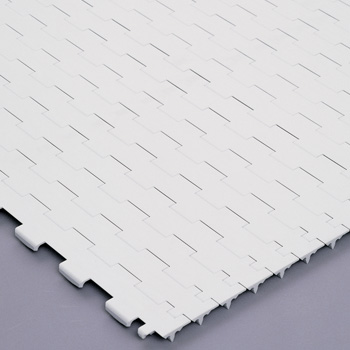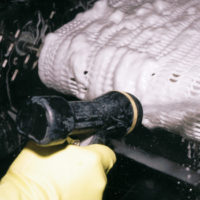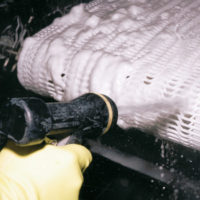Higher Standards for Clean

Good hygiene doesn’t happen without a little work—in any situation. In an industry where food safety is paramount, standards of cleanliness rise with each passing year. Fortunately, for meat and poultry producers, there’s good news: Intralox is doing the hard work so you won’t have to. Through research developments and innovative products, Intralox is setting the industry standard for clean.
Equipping your conveyor with belts, sprockets, and hinges designed for effective cleaning greatly assists in raising hygienic standards. Clearing debris is an essential starting point for any sanitation effort on food-related applications. When debris is allowed to build up on a carryway or on the interior components of a conveyor, problems arise such as production delays, shutdowns, or product recalls. In addition, labor time and water usage can be wasted as a result. Intralox products are used in many applications all over the world. Extensive studies of different plants have led Intralox to tailor its EZ Clean family of components to meet specific sanitation challenges faced by food manufacturers. The result is conveyor cleaning that is both thorough and cost-efficient (www.intralox.com/intraloxclean.htm).
Intralox’s latest sanitation innovation is the Series 1650 SeamFree™ Minimum Hinge Flat Top belt. The belt’s patent-pending flume design and drive bar mechanism channel water and debris to the belt’s edges and prevent debris from being pressed into the hinge area. The belt features 75% fewer hinges than other belts, providing greater rod exposure and increasing overall cleanability.
The Series 1650 SeamFree Minimum Hinge Flat Top belt has 18-inch (457 mm) modules and can be used in applications with transfers as tight as 1.5 inches (38 mm). As with all belts in the EZ Clean family, it is molded from non-porous, non-absorbent plastics that contain no pockets or recessed areas in the underside of the belt that can harbor debris or soils.
Wet lab tests by Intralox report significant savings in labor costs and water usage when using the Series 1650 SeamFree Minimum Hinge Flat Top belt. When used in conjunction with the Intralox EZ Clean In Place system and Angled EZ Clean Sprockets, food processors can expect to clean belts as consistently as manual methods using 65% less time and less water usage. By reducing the amount of heated water needed during each cleanup shift, processors will benefit from a reduction in total energy costs.
The Clean Belt Checklist
Not all modular plastic belts produce superior sanitation results. Gary Larsen, the Technical Support Director for Hygienic Services at Intralox, suggests using this checklist when reviewing potential suppliers to be sure their products are right for your operation:
1. Do the belt hinges open wide around the sprockets, but stay closed on the conveyor bed? Slotted open-hinge belt designs leave space for particles and scraps to accumulate. “Intralox’s Series 800 Open Hinge Flat Top belts feature special Cam-link hinges, which are the most open of any modular plastic flat top belt on the market,” Larsen says. “These hinges open wide around the sprockets to maximize cleaning access to the hinge area, but close on the conveyor bed to prevent debris from clogging the belt.”
2. Are the hinge openings large enough to allow spray to reach both the bottom and top surfaces? If not, water spray cannot reach all areas where soil or chemical residuals exist.
3. Do the belts allow catenary sag for better cleaning access, or must they be tensioned tightly against the conveyor surface? Catenary sag enables better cleaning because the extra space allows more water spray to reach and loosen soils and scraps in the hinge area inside the conveyor frame.
4. Do the belts include drive bars underneath to channel away water and debris? Underside drive bars provide for easy soil removal by detouring water and debris to the outside of the belt and away from the production line.
5. Have the belts been tested for sanitation and cleaning under realistic plant conditions? It is important for easy-clean belt designs to be thoroughly tested to validate or improve their sanitation-friendly features. Larsen says, “For example, Intralox has a wet test facility dedicated exclusively to the scientific testing of plastic belt cleaning procedures and comparative testing of plastic and other belt technologies. The lab measures a number of cleanability factors, including water flow, cleaning time needed and water usage required, in order to realistically project how Intralox belts will increase sanitation success in a working plant environment.”
6. Will the belt company provide group seminars on sanitation issues and best cleaning practices? Notes Larsen, “The expertise of the belt company can help the processor go beyond basic sanitation goals. The Intralox Clean Team offers guidelines and seminars that advise food processors about sanitation friendly conveyor design elements like low belt tension configurations for improved cleaning access and devices that facilitate debris removal.”
www.intralox.com
Looking for a reprint of this article?
From high-res PDFs to custom plaques, order your copy today!





